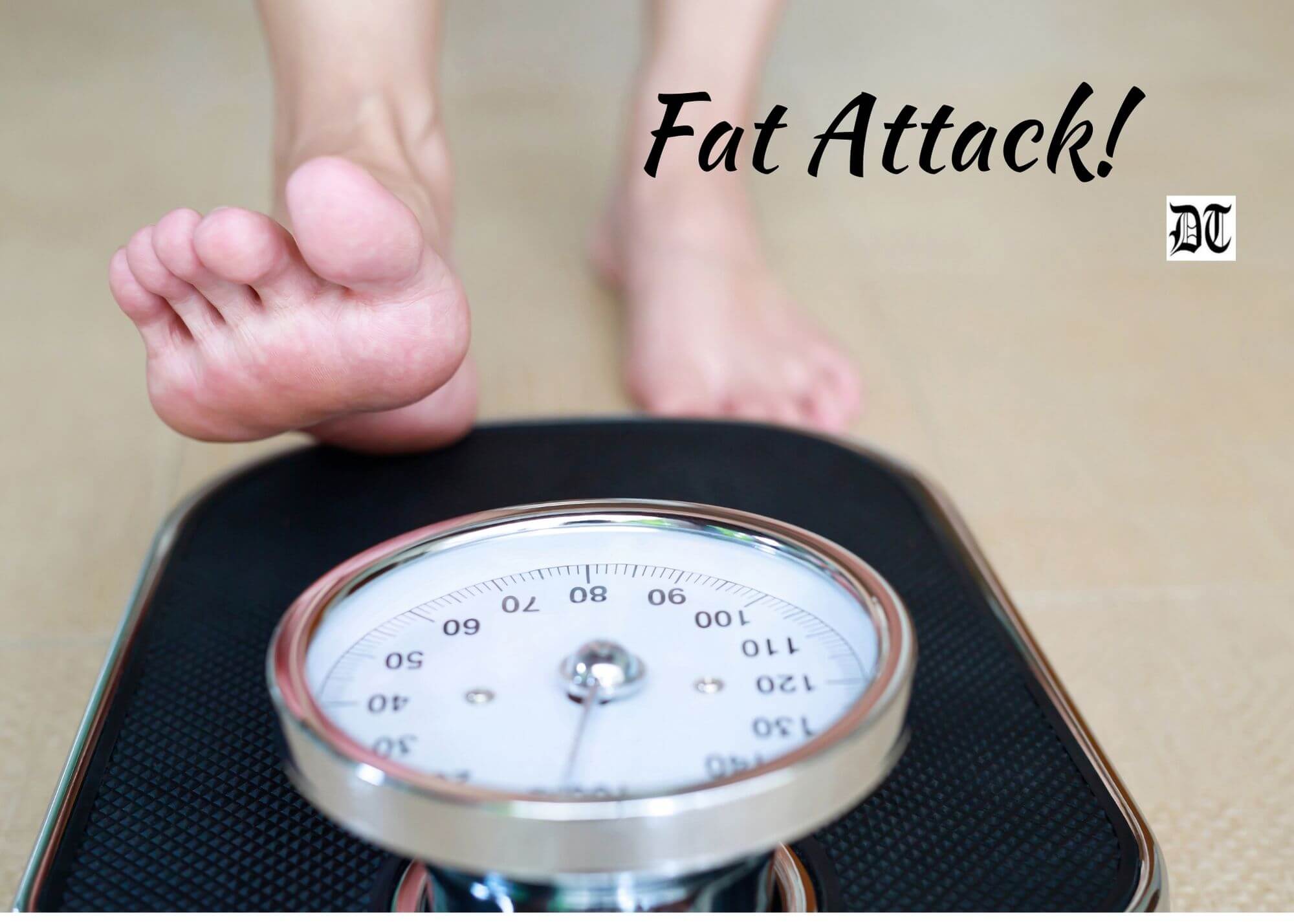Sedentary lifestyle and fast food, other than genetics, age, and few other factors, are the cause of excess fats in our bodies. Parna, a London-based Nutritionist and Fitness Consultant, gives us invaluable tips to understand and manage the fats in our bodies. Here are the ready-to-use tips to deal with the fat attack, in Different Truths.
Every other day in my Nutrition Practice, I find people asking me questions like ‘How do I reduce my belly fat?’ , ‘Why is my belly sticking out even though I have become slim ?’, ‘Why am I not losing belly fat even though I am doing 100 sit-ups/crunches each day ?’ etc.
I realise that belly fat is a big cause of frustration among many people these days.
This has goaded me to write this article about the fat in our body and how to deal with it.
Well, let’s first understand what our body is composed of?
Our body is composed of muscles, bones, water and fat. This is what our body composition tells. Measurements such as BMI, waist to hip ratio and general weight are inexpensive ways to determine appropriate weight and health risk status of individuals but unfortunately, they do not tell anything about the body composition of the individual. Body composition varies greatly between individuals. It depends on various factors like:
- genetics
- gender
- age
- diet
- activity
Now let me explain you the various components of the body composition.
- Fat mass: This is the portion of your body that is fat. Fat mass includes both fat stored in the fat cells and essential body fat
- Essential body fat: These are the fats found in the body that are essential to the normal structure and optimal functioning of the body. These are truly vital to our body.
- Non-essential body fat: This is the fat which is stored in the fat cells (the adipose tissues). Also called ‘storage fat’
- Fat-free mass: This is the total weight of the body except for its fat. This is mainly made up of skeletal muscle and bone, also includes protein, water, fat-free organ weight e.g., the weight of heart, liver, etc.
- Lean body mass: This is the portion of the body that consists of fat-free mass and the essential fats that include those tissues
- Percent body fat (%BF): The amount of fat mass found on the body expressed as a percentage of total body weight
Non-Essential Stored Body Fat
Now, coming to the non-essential stored body fat, it can further be divided into two types, visceral fat and subcutaneous fat. It’s quite important to understand the difference between these two kinds of fat especially if you are an individual, who is trying to achieve certain fat-loss goals.

Difference between Subcutaneous Fat and Visceral Fat
Starting with subcutaneous fat, this type of fat is found right underneath your skin. Subcutaneous means “situated under the skin,” which tells us what subcutaneous fat is: it’s fat that’s all over your body under your skin. It’s what wiggles and jiggles and we’re most concerned with when we want to lose fat. Usually, subcutaneous fat levels are what fluctuate most when you “bulk” and “cut.”
This fat can be easily burnt off through proper exercise. Subcutaneous fat is also responsible for causing cellulite. So if you manage to burn it off, the better your skin will look.
Moving on to visceral fat, this particular kind of fat sits around the body’s organs. Visceral means “having to do with the organs”, especially those in the abdominal cavity. Hence, visceral fat is body fat that’s stored around several organs in the abdominal cavity including the liver, pancreas, and intestines. Visceral fat can’t be felt or pinched as it lies beneath your abdominal wall. Often, an expanding belly is the result of an increase in both types of fat. The subcutaneous fat is the fat we can feel and the visceral fat is the fat we can’t.
Although, having an excess amount of both these fats are unhealthy but research shows that subcutaneous fat per se isn’t as dangerous to your health as the visceral fat. Do you know why?
This is because the higher amounts of visceral fat cause an increased risk of various types of disease including type 2 diabetes, heart disease, insulin resistance, and dyslipidemia (abnormal triglycerides).
Let’s Find out How?
Visceral fat releases fatty acids and pro-inflammatory chemicals. Due to the fat’s proximity to the portal vein, these chemicals find their way into the liver. This tainted blood causes problems in the liver including insulin resistance and steatosis. (Steatosis, also called adipose degeneration, is the process describing the abnormal retention of lipids within a cell). Thus, numerous health problems ensue.
Whereas subcutaneous fat, on the other hand, release more beneficial than harmful chemicals, such as leptin (fat burning hormone) and adiponectin (glucose regulation and fatty acid oxidation hormone).
Measuring Visceral Fat
These days there are so many devices available for measuring the visceral fat for e.g., the Body Composition Monitors, Fat monitors, MRI, CT-Scan, etc., but the simplest way to determine if you have too much visceral fat is to measure your waistline. In women, a waist measurement of 35 inches or higher is generally a sign of excess visceral fat. In men, it’s 40 inches or higher.
Why do Many People have Large Amounts of Visceral Fat?
There are several factors responsible for large amounts of visceral fat which can be broadly classified into these categories, genetics, hormones, age, diet and possibly even birth weight (smaller babies may be predisposed to gain more belly fat later in life).
- Genetics: Research shows that several genes may be associated with increased levels of abdominal fat. A gene called Plexin D1 appears to control both where fat is stored (e.g., Apple Shaped or Pear shaped body) and how fat cells are shaped, known factors in health and the risk of future disease.
- Hormones: Post-menopausal women tend to store more visceral fat due to the hormonal changes that occur (primarily the decrease in Estrogens). Similar is the case with Andropause men due to low testosterone levels.
- Age: As people get older, they tend to move less and lose muscle. This increases the risk of obesity and other disease and dysfunction, as well as the tendency to gain visceral fat.
- Diet and Lifestyle: High-fat food is associated with higher levels of body fat (and the fatter someone is, the more visceral fat they will inevitably have). A sedentary lifestyle increases the risk of being overweight and having higher levels of visceral fat. Drinking large amounts of alcohol causes higher amounts of visceral fat in both men and women. Research shows that trans-fats are preferentially stored as visceral fat. That’s why visceral fat contains high amounts of trans-fatty acids and thus consuming trans-fat is highly responsible for excess abdominal fat.
How to Reduce the Visceral Fat?
As you can see, genetics and hormones aside, the recipe for visceral fat gain is little-to-no exercise, overeating, eating crappy foods that contain trans-fats, and drinking alcohol regularly. Here are some things you can do to reduce the visceral fat.
Burn more Energy than you Consume
- Avoid consuming trans-fats: Check the food labels to see if there are any trans-fats. Examples of foods containing trans-fats are fried fast foods, frozen pizza, sausages, doughnuts, margarine, biscuits, cakes, etc.
- Avoid sugar and sugar-sweetened drinks: Sugar is half glucose, half fructose, and fructose can only be metabolized by the liver in any significant amount. When you eat a lot of refined sugar, the liver gets overloaded with fructose and is forced to turn it all into fat. Numerous studies have shown that excess sugar, mostly due to the large amounts of fructose, can lead to increased accumulation of fat in the belly.
- Eat foods rich in fiber, especially viscous fiber: Dietary fiber is mostly indigestible plant matter. It is often claimed that eating plenty of fiber can help with weight loss. This is true, but it’s important to keep in mind that not all fiber is created equal. It seems to be mostly the soluble and viscous fibers that have an effect on your weight. These are fibers that bind water and form a thick gel that “sits” in the gut. This gel can dramatically slow the movement of food through your stomach and small bowel, and slow down the digestion and absorption of nutrients. The end result is a prolonged feeling of fullness and reduced appetite. The best way to get more fiber is to eat a lot of plant foods like vegetables, fruits (in moderation), Legumes as well as some cereals like oats.
- Cut down on the alcohol: Cut down the frequency as well as the amount of alcohol intake. Now you know why it is called ‘The Beer Belly’.
- Do resistance training and High-Intensity Interval Training (HIIT): Muscles are the fat burning machines of your body. Weight training effectively builds muscle so your body burns more calories at rest. Weight training combined with cardio provides the greatest belly-fat loss.
- Avoid Stress: Keep your cortisol levels under control. Cortisol is a catabolic hormone that your body produces in response to stress. Research shows that high levels of cortisol skew the distribution of body fat to the abdominal region.
- Maintain good sleep hygiene: Research shows that both too little and too much sleep can increase visceral fat. People who sleep five hours or less and people who sleep more than eight hours both show an increased visceral fat.
Thus, you can see that even though there are few things like genetics, age, etc. that are beyond our control but still there are several ways which are in our hands and can help us to keep a check on our body fat level if we incorporate them into our daily lives.
Picture design by Anumita Roy, Different Truths





 By
By
 By
By

 By
By